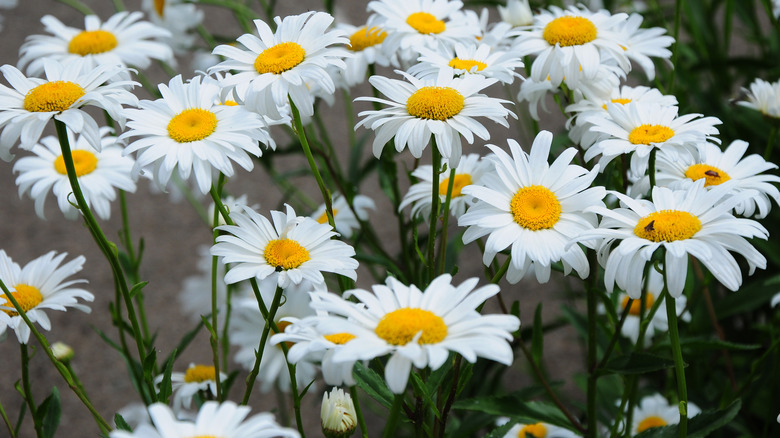The Best Varieties Of Shasta Daisies To Enjoy Colorful Blooms All Summer Long
For a beautiful scent that may remind you of a grandma's cottage garden, Shasta daisies (Leucanthemum x superbum) are a quintessential planting choice. While evocative of an idyllic gardening scene, these timeless beauties also serve as a stunning daisy variety that will fill your yard with pollinators. However, most Shasta daisies' summer blooms don't last longer than four to six weeks, abjectly cutting their season short. But you can keep the flower party going all summer long by planting popular varieties like Snowcap and Becky.
Typically winter hardy in zones 5 to 9, Shasta daisies start putting out flowers when spring gives way to summer, kicking off the sunny weather in style while playing host to butterflies. But most cultivars exhaust their blossoms from June to September, unless their spent petals are removed in time to inspire another flush of flowers. Luckily, their semi-evergreen, waxy foliage continues to lend the yard visual interest throughout the dreary winters as a perennial. But for those in warmer climates, extreme heat can kill the plant and it must be treated as an annual.
Plant Snowcap in small gardens to kickstart the flower fiesta early
With starch white petals radiating out of yellow eyes, Snowcap is a classic Shasta daisy and is winter hardy to zone 4, unlike other Shasta daisy varieties. But its diminutive size sets it apart — the fast-growing herbaceous perennial tops 14 inches at maturity while measuring 12 inches across, making it suitable for fronting garden borders. Alternatively, you can grow and care for Shasta daisy plants in small pots if you prefer container gardening. In mixed borders, accent it with daylilies, salvia, or tickseed flowers.
Snowcap will reward you with large, single blooms from late spring through summer (usually July to September, depending on your location) when planted in full sun. Also, it needs its soil drain well and never be soggy. Additionally, this Shasta daisy variety has great drought resistance (improved further due to its small stature), meaning there's no need to water the plant unless the top 2 inches of the substrate feel dry to the touch — a brilliant way to jump on the bandwagon of water-wise gardening. However, don't forget to deadhead the plant regularly to extend its flowering season and separate it every couple of years and give extras to your gardening friends.
Grow Becky for its bigger flowers and phytophthora resistance
Ever since its crowning as the "Perennial Plant of the Year" in 2003, Becky has only seen its fortunes grow, and for good reason. Standing almost 3 feet high and 2 feet across, Becky is taller than most shasta daisy cultivars, and over ⅔ of its length is devoted to flowers alone! So, you're still looking at the archetypal, gorgeous, yellow-centered, single, white flowers but at a bigger scale. Fortunately, the bigger blooms don't make the plant top-heavy, doing away with the need for staking to keep the flowers from nodding and marring their beauty. To boot, these cultivars resist Phytophthora fungus better, lowering the possibility of their crowns or roots decaying prematurely.
What's even better is that Becky starts blooming in the summer, lasting well into the fall. Succession planting can make the most of your garden space, so plant it next to Snowcap for an extended blooming season for flowers that grow bigger as the season ends instead of growing smaller, as is often the case for second flushes. Like Snowcap, Becky needs full sun and well-draining soil. Deer and rabbits typically steer clear of these ostentatious beauties.


